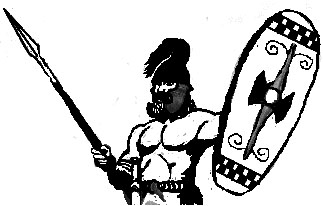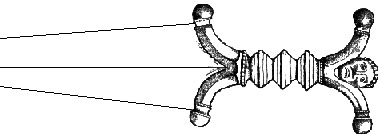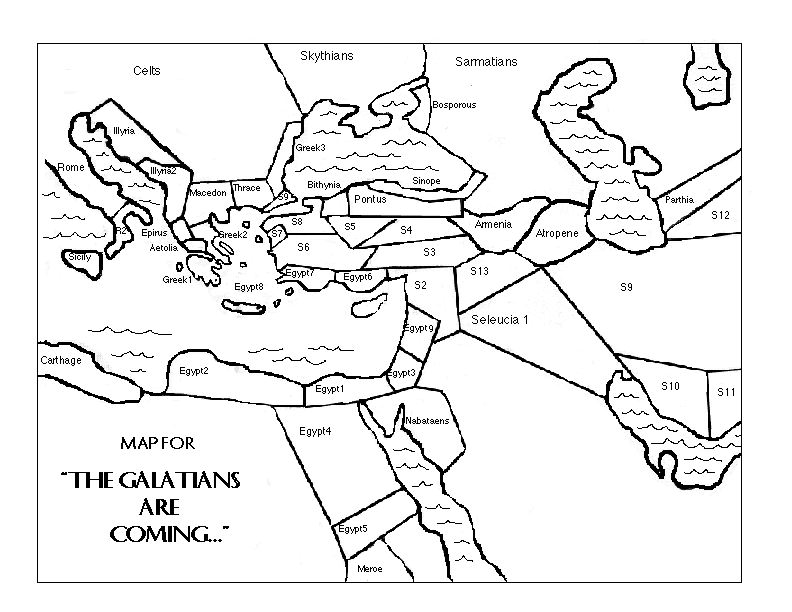 Their line steady, the Seleucid army awaits the warband's assault in the third year of the Celtic invasions. Armor and pike tips glistening, elephants trumpeting, horses snorting, they make quite a contrast with the naked hordes they face. After years of fighting across the empire, another battle doesn't faze them, nor do the Galatians fear the coming conflict. Let the bloodletting begin!
Their line steady, the Seleucid army awaits the warband's assault in the third year of the Celtic invasions. Armor and pike tips glistening, elephants trumpeting, horses snorting, they make quite a contrast with the naked hordes they face. After years of fighting across the empire, another battle doesn't faze them, nor do the Galatians fear the coming conflict. Let the bloodletting begin!
Returning to wargaming after a 15-year hiatus, I wanted to avoid my past mistakes of accumulating piles of lead that would never be painted, and wanting to fight battles I didn't have enough space for. I discovered the answer, at least for Ancients wargaming, in De Bellis Antiquitatis (DBA). Small armies and small battlefields -- just what I needed. As I fought (usually solo) battles to learn the rules, I soon discovered another hole in my gaming world -- playing individual games without a context to put them into grew tiresome very quickly. Thus, a campaign was in order.
Fortune smiled on me, as she rarely does when I'm rolling the dice, and the July 1997 issue of Slingshot, the house organ of the Society of Ancients, had an article describing a set of campaign rules that fit my needs reasonably well. John Graham Leigh's "Solo Campaigning" was designed for DBM, a larger scale ruleset (too many figures and too much space for me), but translated easily enough into a setting for DBA. Dice rolls determine which armies fight each other, and you go from there. Easy enough!
I made adjustments to produce more battles, as DBA doesn't require the time to fight that DBM does. A couple of battles is easy enough to do in an evening. I also added features to reflect the somewhat different situation I was working with to keep some of the historical flavor. Thus, Pyrrhus' fighting is largely defined by the scenario, not the dice, and Rome is also controlled by special rules, rather than the normal pattern. There are revolts and changing Aggression Ratings (more on these below) built into the system, also reflecting the flow of history as it was, to help move the campaign in the direction I want it to go. Ain't it great being Zeus?
Set up didn't take long. I started by making the map. I merely traced the eastern Mediterranean out of an old National Geographic atlas and drew in the political boundaries I wanted. I subdivided the larger empires, so that Seleucia had thirteen subsections and Ptolemid Egypt ten. This allows these empires to avoid destruction in one or two turns, and given the ease of fighting multiple DBA battles, makes sense for my needs. The various powers are each assigned Aggression Ratings (AR), loosely based on the DBM army lists, but tailored to fit the campaign objectives. I want the focus to be the Hellenistic region, but allowed the periphery to participate. I cut back the AR's to keep their participation subdued.
 I begin a turn by rolling a die for each potential combatant (22 at the moment), then add their AR's to the results. If there are more than three I use the dice again to narrow them down. Then I roll dice for the neighbors of each aggressor, and discover who their victims will be. And that's all there is to it. With my over-ambitious arrangement, I have lots of dice rolling, but it doesn't take that long, and it would be easy enough to limit the campaign to the major powers. I like the flavor the "little guys" add to the campaign, so I roll more dice.
I begin a turn by rolling a die for each potential combatant (22 at the moment), then add their AR's to the results. If there are more than three I use the dice again to narrow them down. Then I roll dice for the neighbors of each aggressor, and discover who their victims will be. And that's all there is to it. With my over-ambitious arrangement, I have lots of dice rolling, but it doesn't take that long, and it would be easy enough to limit the campaign to the major powers. I like the flavor the "little guys" add to the campaign, so I roll more dice.
Below are the basic rules for the campaign. Each turn represents five years (the first five turns in this campaign are single years to reflect the tremendous amount of activity taking place then.)
- 1. Roll 1D6 for each active area, add the result to the AggressionRating (AR). Three highest will attack. Use modified AR to determine sequence of battles, with the highest going first.
2. Roll for neighbors of aggressors. Subtract the neighboring areas' AR. The highest resulting number will be the defender.
3. A successful attack makes an area tributary; after a defeated attack roll 1D6 to determine next turn's action: 1-2 continue attack, 3-5 abandon attack, 6 counterattack.
4. Tributaries continue to follow rule #1. If the result is one of the three highest, they revolt.
5. If attacked and attacking on the same turn, the attack cannot be made if the previous defensive engagement was lost.
6. Subtract 1 from AR rolls of defenders across seas. Exceptions for S8-9 (Hellespont), R2-Si1 (Straits of Messina).
7. Add 1 to AR (max. 3) for one turn after a victorious attack.
8. Subtract 1 from AR (min. 0) the turn after participation in 2+ battles in one turn.
9. If a sea invasion is attempted, roll 1D6. 1-2 result in a preliminary sea battle, 3-6 result in immediate invasion.
As I indicated above, there are a bunch of special rules to reflect the particular historical context, but I really didn't need to go beyond the basic set. So far, between the main rules and the special situations rules, there have been seven battles each turn. That seems a reasonable amount to play, and will allow the campaign to go on for quite a while. I can also see using this set of rules for campaigns in the 19th century colonial period, which is my other main area of interest. I randomize selection of terrain, using dice to determine the type and placement, again based on DBM's army lists. I make sure that the DBA requirements are met, but otherwise let the dice rule. It's made for a lot of interesting battlefields! I should probably make an adjustment to permit the defender to have a greater effect on terrain selection, but the random method is working fine so far.
Thus far, the Galatians have made inroads in Thrace and the west coastof the Black Sea, while Antigonus has conquered Macedonia and Peloponnesia, but lost Athens and environs to a revolt. Pyrrhus has proved to the great general Hannibal believed him to be, winning all his battles, though his victories against the Romans have truly been Pyrrhic. The Romans can't wait for the Polybian reforms...lots more Blades! And Pyrrhus doesn't know that he dies, by definition, in three more turns. (Zeus again!) Seleucia and Pontus have also made some territorial gains. The Galatians haven't made it to Galatia yet, but the battle I began this article with may be the next step on the way. I'll let you know.
Map

Back to The Herald 24 Table of Contents
Back to The Herald List of Issues
Back to MagWeb Master Magazine List
© Copyright 1998 by HMGS-GL.
This article appears in MagWeb.com (Magazine Web) on the Internet World Wide Web. Other articles from military history and related magazines are available at http://www.magweb.com